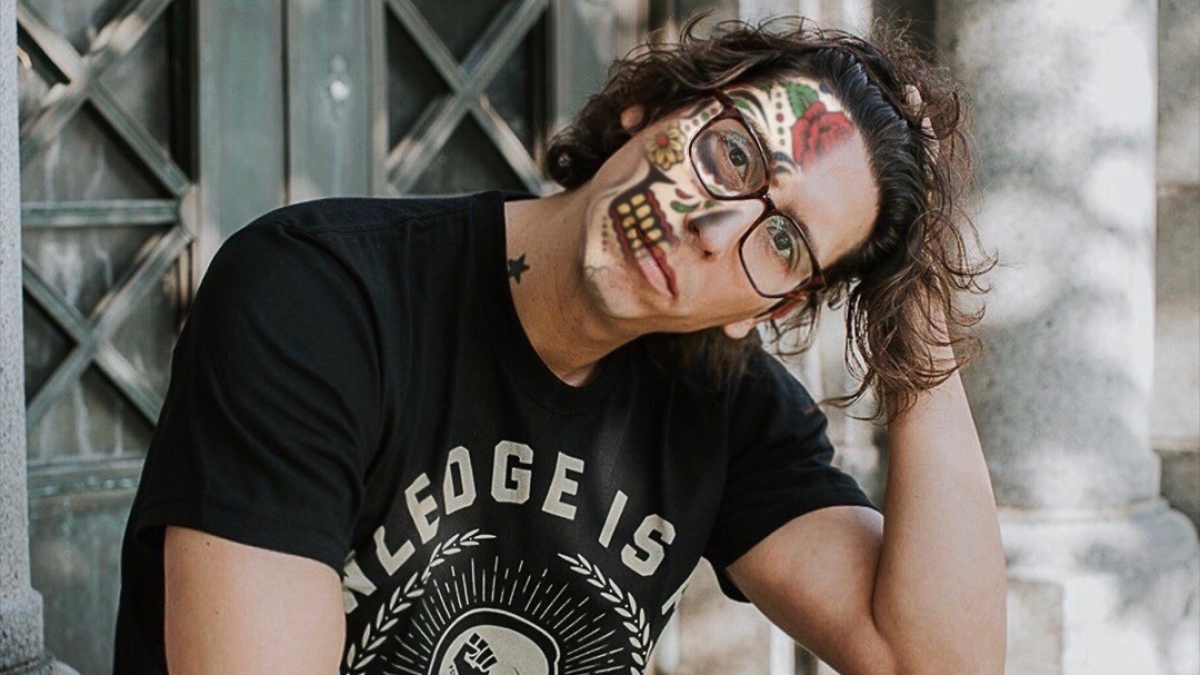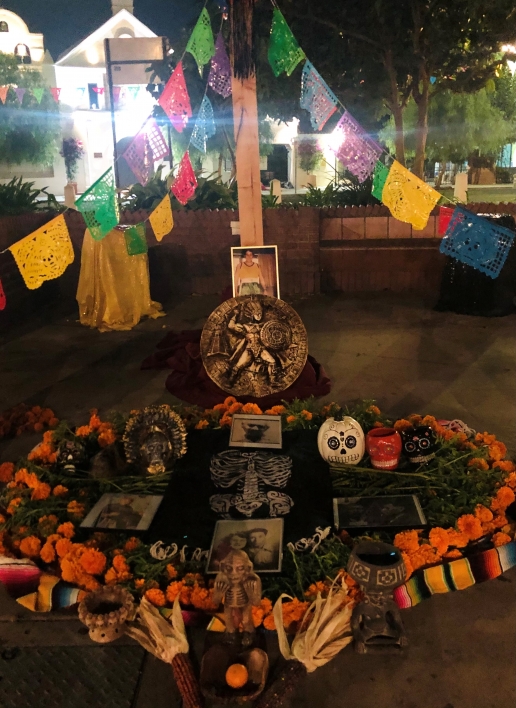ASU teaching professor brings Día de los Muertos to life through research, ritual

Mathew Sandoval, associate teaching professor at Barrett, The Honors College at ASU, with his face painted in Día de los Muertos style. Photo provided by Mathew Sandoval
Mathew Sandoval’s research about Día de los Muertos is more than an academic exercise.
“As a Chicano who makes Día de los Muertos altars for my ancestors, I wanted to know more about the history of the holiday, so my research came from a deeply personal place,” said Sandoval, associate teaching professor at Barrett, The Honors College at Arizona State University.
Traditionally celebrated on Nov. 1 and 2, but sometimes in late October, Día de los Muertos (also called Day of the Dead) is widely observed in Mexico as a way to remember friends and family members who have died.
Día de los Muertos takes on a celebratory tone at gatherings, featuring mariachi music, folkloric dancing and colorful altars — called ofrendas. The ofrendas are laid out with things the dead enjoyed while they were alive, such as photographs, items families consider sacred and significant, and traditional elements like food, candles, flowers, incense,and skull and skeleton figurines.
Sandoval’s research focuses on public Día de los Muertos celebrations in the United States and Mexico, and Day of the Dead’s historical development from Mexico’s pre-Hispanic era to the 21st century.
He began studying various large-scale cultural performances, like Mardi Gras in New Orleans and Carnival in Rio, and various kinds of ritual pilgrimages about 20 years ago in graduate school at New York University. From that, Día de los Muertos emerged as a top-line subject for him.
“For millions of Mexican-Americans, Mexicans and Latinos, Día de los Muertos is one of our most sacred and significant holidays. We take time at the end of October and beginning of November to remember the loved ones we’ve lost and honor the ancestors who came before us,” Sandoval said.
“By honoring our ancestors, we stay connected to our culture, our values and our sense of self. The holiday also makes us deal squarely with death, rather than fear it or hide from it. Day of the Dead is an occasion to acknowledge that death is an integral part of life, rather than a negation of life,” he added.
Sandoval said Día de los Muertos also provides a cultural tool to work through the difficulty and pain of death.
“It’s an occasion for us to intentionally activate our grief and transform it into something beautiful, vibrant and joyous through dance, music, feasting, telling stories, masquerading and celebration. By transforming grief in these ways, Day of the Dead becomes a deep form of healing. Día de los Muertos is also a lively and joyous occasion because it’s a reminder that we are alive,” he said.
Mathew Sandoval built this ofrenda in remembrance of his grandfathers at Placita Olvera in downtown Los Angeles two years ago. Photo courtesy Mathew Sandoval
Sandoval marks the holiday by constructing multiple ofrendas in his home and office and participating in the community celebrations that he researches, whether that’s in Los Angeles, Mexico City, Phoenix or Tucson.
“Traditionally, the ofrenda was meant to operate as ritual technology. Its purpose was to bring the spirits of the dead back to the land of the living. Nowadays the ofrenda typically operates as a memory device. It’s designed as an installation that allows the living to remember and pay homage to those who have died,” Sandoval said.
Día de los Muertos is growing in importance because of its increasing popularity and celebrations sprouting up in new locations across the globe every year, Sandoval said.
“Even more, Day of the Dead is an incredibly dynamic living tradition, which means that it’s constantly evolving in profound ways,” he added.
Day of the Dead and Halloween have started to blur and blend together in Mexico and the U.S. in the past several decades, in large part because major corporations, mass media and Hollywood heavily market and advertise both in Mexico and the U.S., he said.
For example, in Mexico, Halloween objects have made it into nearly every store, Halloween shows appear on television and Halloween horror movies are shown in theaters. Day of the Dead products have become available at mass retailers across the U.S. like Walmart and Target, and Disney has also gotten in on the action with Day of the Dead-themed merchandise, events and its blockbuster movie “Coco.”
“The result is that the two holidays are becoming conflated. I don’t necessarily see this as a bad thing. These two holidays share similar cultural roots and are really kindred spirits. It’s rather fitting, then, to see people combining them in such dynamic and interesting ways,” Sandoval said.
He notes that there are instances where the holiday has become overly commercialized and appropriated. For example, Disney attempted to copyright “Día de los Muertos” in anticipation of the release of “Coco.” And almost none of the widespread commercial products available are made by Mexican artists.
However, the discourse around commercialization and cultural appropriation is tricky, he said.
“The brown-skinned Day of the Dead Barbie Doll is a good example. The Mattel corporation is blatantly trying to appropriate and capitalize on our culture heritage. On the other hand, they are giving young Latinx kids an opportunity to see themselves represented, and representation is exactly what people are demanding,” he said.
In The Human Event, a seminar course Sandoval teaches at Barrett, The Honors College, death and afterlife are themes that are touched on. Sandoval’s students attend a local Day of the Dead celebration, and then write about their experiences and discuss them in class.
“They have to analyze Day of the Dead and make sense of it the same way they would any other art work, book, movie or theater performance we cover. The assignment also gives us an opportunity to talk about the meaning of death across various cultures,” he said.
Sandoval also shares his Día de los Muertos knowledge through articles and workshops. Read his latest take on the relationship between Halloween and Día de los Muertos and how "La Catrina" became a symbol of Day of the Dead.
More Sun Devil community

A champion's gift: Donation from former Sun Devil helps renovate softball stadium
Jackie Vasquez-Lapan can hear the words today as clearly as she did 17 years ago.In 2008, Vasquez-Lapan was an outfielder on…

Student-led business organization celebrates community, Indigenous heritage
ASU has seen significant growth in Native American student enrollment in recent years. And yet, Native American students make up…

Remembering ASU physical chemist Andrew Chizmeshya
Andrew Chizmeshya, a computational chemist and materials scientist whose work spanned over three decades at Arizona State…


